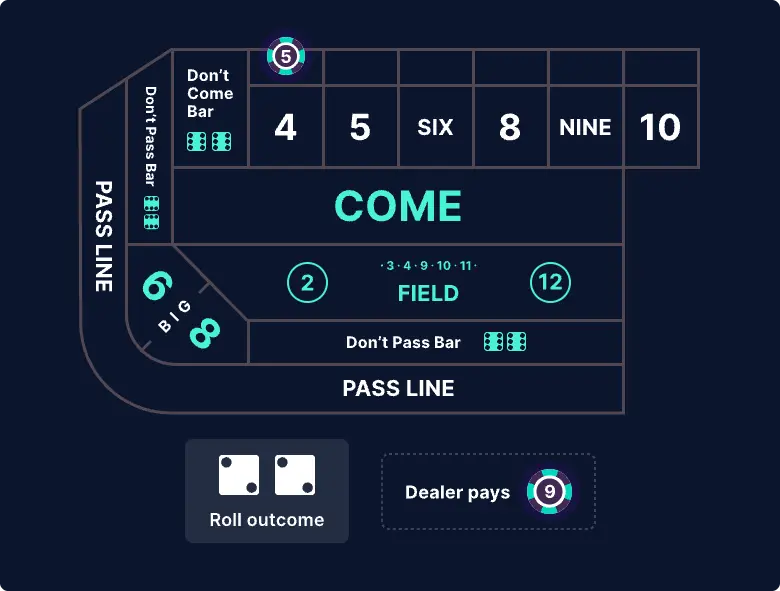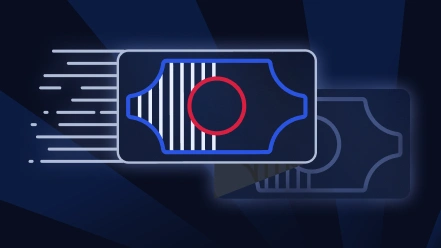
Craps Payouts & Odds Guide
To increase your chances of winning at craps, it's essential to know which bets have the best odds and how much they pay out. Use our craps payout chart and craps bets odds guide to help you find out how much you can potentially win in your next online game.
What are the Payout Odds in Craps?
The payout odds in craps can range from 30:1 to 1:1 and are determined by the true odds of a bet and the house edge (also known as the house advantage).
The true odds refer to the probability of winning a particular bet. For example, if the true odds are displayed as 2 to 1, this means that on average, for every one time you win, you should also expect to lose twice. A payout of 1:1 is called even money, meaning you win the same amount as you wagered.
The house edge, meanwhile, is the difference between the true odds of a bet paying out and the actual odds a casino pays to the winner. The lower the house edge, the better for the player.
In craps, one of the chief betting strategies for increasing winnings is to reduce the house edge as much as possible. On some bets, the house edge can be as high as 16.9%, which can result in a substantial loss over the course of a craps session.
Craps Payout Table
Check the payout odds for all craps bets using the craps payout charts below or learn more about different wagers on our craps bets page.
Pass Line Odds / Come Bet Odds / Buy Bets (5% commission)
Don’t Pass Odds / Don’t Come Bet Odds / Lay Bets (5% commission)
Place Bets
Field Bets
Hardways
One Roll Bets
One Roll Bet Pro Tip
There are many one roll bets, such as a Field bet or Hop bet. They are considered side bets, which often come with higher house edges. Most of them carry high vigorish (vig), a commission charged for placing a bet. These are usually best to be avoided by the average craps player.
Defining the House Edge
Casinos use the house edge to determine the percentage of initial wagers from players that they can expect to earn over the long term. The house edge is calculated using craps rules to ensure that even when players land a big payout, the casino can mitigate its losses.
Craps has one of the lowest house edges compared to other casino games. The Asian dice game, Sic Bo, for instance, has a house edge of up to 33.3% on some wagers.

Don't Forget About House Edge
It’s important to incorporate the house edge in any craps strategy you want to use, as it changes with each type of bet. We recommend using the true odds to determine the chances of a bet landing, and the payout odds to objectively decide whether the winnings are worth the risk.
Using the true odds of landing a 7 in a craps game as an example, the true odds are 5 to 1, meaning if a player bets $10 and wins, they should receive $50.
However, due to the house edge, the payout odds of landing a 7 are 4 to 1, and the player will actually receive $40 for their winning bet.
How to Calculate Payouts
To calculate any payouts in craps, remember to use the payout odds and not the true odds when making bets. Some beginner players find it easier to quickly calculate payouts on winning bets by breaking the payout odds into units.
Looking at a craps table, the payout odds for landing a 4 are 9:5. This means that for every $5 bet you win, the dealer will pay you $9.

Let's say you're at a craps table with a $10 minimum bet and you want to bet on 4. Using the payout odds of 9:5, you know your minimum bet of $10 equates to two $5 'units'. You need to multiply the total number of units you want to bet by the amount the casino will pay out if the bet wins.
Using the payout odds on landing a 4, you multiply 2 by 9 to get 18. This means that your $10 bet will win $18 if the 4 lands on the dice.

Calculating Payouts for Irregular Betting Amounts
To calculate the payout in craps for any bet, you need to convert the payout odds from a fraction to a decimal, then multiply this by the amount you want to wager to determine the potential payout.
For example, a bet on point 4 in craps has payout odds of 9:5. When converted to decimal form, this is equivalent to 1.8. For a $10 bet, multiply 10 by 1.8 to calculate a payout of $18 if the dice landed on 4.
Best and Worst Payout Odds on Craps Bets
Best
Pass Line
Don’t Pass/Don’t Come
Odds Bet
Worst
One Roll Bet
Horn Bet
Lay Bet
How Do Craps Dealers Calculate Payouts?
Dealers must calculate payouts for up to 20 players at any time in a craps game. Given how fast-paced a game can be, dealers have several tricks up their sleeve to keep track of bets and payouts for players:
Chips are arranged in a certain order
Dealers ensure that the chips around the table are arranged in relation to a player's bank rack position. Depending on where a player has stored their chips on a craps table's chip rack, a dealer will place the player's chips in the corresponding position around the boxes of the specific bet.
Payouts are given in a specific sequence
The boxman and dealers pay out bets in a strict order to keep the process organized. Dealers pay out winnings in the following sequence: ‘pass line bets’, ‘come bets’, and ‘place bets’.
Bets are paid out from the player closest to the stickman
To keep track of payouts for ‘place bets’, the dealers will start with the player located next to the stickman, and then pay out winnings in sequential order. Some real money craps casinos will vary the start point between the stickman and boxman for certain bets.
Dealers memorize payout odds
A craps dealer will have to calculate the same ‘pass’, ‘place’, and ‘come bets’ many times a day. While online casinos will use software to calculate payouts, dealers in land-based casinos gradually memorize the various payout odds in a craps game, resulting in a fast-paced game with quick bets and payouts.
Learn to Play Craps Free
Before you hit the craps table for real, why not hone your skills and understanding with our free Craps game?
FAQs
What are the best odds in craps?
The ‘pass bets’, ‘don't pass bets’, and ‘laying odds bets’ have the best odds in craps. ‘Pass bets’ have payout odds of 1:1, meaning you can effectively double your money. Plus, the house edge on this bet is only 1.41%. Alternatively, ‘laying odds bets’ are wagers placed after the point is established, and have zero house edge but slightly lower payout odds, at 2:1, 3:2, and 6:5, depending on which numbers you bet on.
What does 3 4 5 odds mean in craps?
The three, four, or five odds refer to the maximum amount a player can make when laying the odds in a craps game. For instance, if a casino has 4x odds in place, it means that the amount players can win will be no more than 4 times the don't pass bet.
What are the payouts in craps?
To find the payouts of all bets in craps, we recommend using a payout odds chart or a craps payout calculator. These will help you immediately find the payouts you can expect to earn on winning bets in craps.
What is an Any 7 or Any Craps bet?
'Any Craps' is a type of craps bet that wins on a 2, 3, or 12, while 'Any 7' is also known as a seven bet that wins on a 7. Both of these are examples of a one roll wager, meaning the next roll of the dice determines the outcome.
What are the odds of rolling a 7 in craps?
In craps, there is a 1 in 6 chance of rolling a 7 on the dice or a 16.67% probability. The game uses two dice, resulting in 36 possible outcomes. Out of that 36, there are six different ways the dice could land on 7. By comparing the possible outcomes by the total number of outcomes, the odds of landing a 7 are 6 in 36.
What is the ‘odds bet’ in craps?
The ‘odds bet’ is a bet that can be made during a craps game, but only after the point is established. Essentially, players bet on the dice landing on a specific number before they land on 7. There is zero house edge on odds bets because the odds are exactly fair, making this a popular choice for craps players. Payout odds differ between the numbers: 2:1 on points 4 and 10, 3:2 on points 5 and 9, and 6:5 on points 6 and 8.



